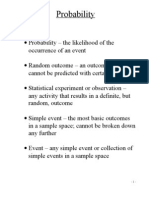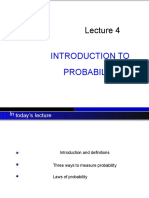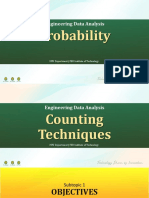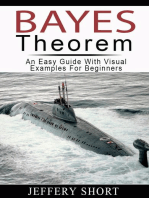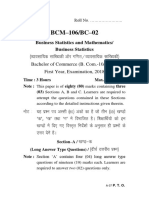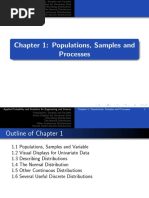Robability: Big Picture
Uploaded by
Javi- NuxRobability: Big Picture
Uploaded by
Javi- NuxP
r
o
b
a
b
i
l
i
t
y
&
S
t
a
t
i
s
t
i
c
s
D
i
s
c
l
a
i
m
e
r
:
t
h
i
s
s
t
u
d
y
g
u
i
d
e
w
a
s
n
o
t
c
r
e
a
t
e
d
t
o
r
e
p
l
a
c
e
y
o
u
r
t
e
x
t
b
o
o
k
a
n
d
i
s
f
o
r
c
l
a
s
s
r
o
o
m
o
r
i
n
d
i
v
i
d
u
a
l
u
s
e
o
n
l
y
.
This guide was created by Lizhi Fan and Jin Yu. To learn more about the student
authors, http://www.ck12.org/about/ck-12-interns/.
Study Guides
Page 1 of 3
Big Picture
v1.1.9.2012
The probability of an event can be calculated by knowing the number of ways the event can occur and the size of
the sample space.
Probability of event A = P(A) =
Probability of an event is always between 0 and 1: 0 = impossible, 1 = always happens
The probabilities of all possible outcomes of an event must add up to 1. This means one of the outcomes must happen.
This method of determining probabilities assumes that all the possible outcomes are equally likely to happen.
Simple Events
Example: the probability that a die will land on 3
Experiment: rolling a single die
Event: the die lands on 3
This is also a simple event because the die can only land on one number (one possible outcome)
Sample space S lists the possible outcomes: S = {1, 2, 3, 4, 5, 6}
Size of sample space = six
P(die lands on 3) =
Non-Simple Events
Example: the probability that a die will land on either 2 or 3
Event: the die lands on 2 or 3
Can be broken down to two simple events: the die lands on 2, the die lands on 3
Sample space S = {1, 2, 3, 4, 5, 6}
Size of sample space = six
P(die lands on 2 or 3) =
There are two ways for the event to happen the die can land on 2 or the die can land on 3
Complementary Events
Complement of an event A = A = all the events other than A in the sample space
Finding probabilities using complements:
P(A) = probability that A doesnt happen
Example: Throwing a die
Event A = observing an odd number, Event A = observing an even number
The Comp lement Rule:
P(A) + P(A) = 1
can be rearranged: P(A) = 1P(A)
The Complement Rule is useful when P(A) is easier to fnd than P(A)
Probability is the study of whether an event will or will not occur. Using the laws of probability, we can fnd the likelihood
of two events occurring together, not occurring, or a large variety of other combinations.
Key Terms
Probability: A measure of how likely an event is.
Event: Something that occurs. Can have one or more
possible outcomes.
Simple Event: An event that has exactly one outcome.
Sample Space: All the possible outcomes of a
experiment.
Outcome: The result of a single experiment.
Experiment: The process of taking a measurement or
making an observation.
Complementary Event: All the other events in a
sample space.
Compound Event: An event made up of two or more
simple events.
Dependent Events: Events whose outcomes do affect
each other.
Independent Events: Events whose outcomes dont
affect each other.
PROBABILITY
Determining Probabilities
Page 2 of 3
P
r
o
b
a
b
i
l
i
t
y
&
S
t
a
t
i
s
t
i
c
s
The probability of compound events depend on the outcomes from two or more events.
Probability of both A and B happening: P(A and B) = (A B) = P(A) P(B, given A)
means the intersection of events
Probability of either A or B happening: P(A or B) = P(A B) = P(A) + P(B)P(A B)
means the union of events
Conditional Probabilities
Conditional probability: the probability of event A occurring, given event B has occurred
Notation: P(A|B), which means the probability of A, given B
P(A|B) =
Can rewrite as P(A B) = P(A|B) P(B)
This occurs when events are dependent, where the occurrence of the event will change the probability of the successive
events from occurring.
For example, taking a king randomly from a set of cards will decrease the probability of another king being taken
out.
Independent Events
If an event is independent, its occurrence does not change the probability of successive trials from occurring.
For example, rolling a six on a die will not change the probability of rolling a six on the next die.
If A and B are independent events, then P(B|A) = P(B).
So P(A and B) = P(A) P(B, given A) = P(A) P(B) for independent events
Mutually Exclusive Events
If two events are mutually exclusive, meaning that they cannot occur together, then P(A B) = 0.
So P(A or B) = P(A B) = P(A) + P(B) - P(A B) = P(A) + P(B)
Compound Probabilities
PROBABILITY CONT.
Page 3 of 3
P
r
o
b
a
b
i
l
i
t
y
&
S
t
a
t
i
s
t
i
c
s
PROBABILITY CONT.
Tree Diagrams & Counting Techniques
Law of Large Numbers
Combination and Permutation
Counting Rule for Combinations
The number of combinations of n objects taken r at a time is:
For example,
13
C
6
is the number of combinations of six objects that can be chosen from 13 objects.
Combination = order does not matter
To remember that order does not matter for combinations, imagine a combo pizza where you choose whatever
toppings you want and just throw it on!
Counting Rule for Permutations
The number of ways to arrange n objects in order within r positions is:
For example,
13
P
6
is the number of ordered ways to arrange six objects chosen from 13 objects.
Permutation = order does matter
For both rules, n and r must be whole numbers, and n r.
Factorial
Factorial notation is a shorthand way to write out a common multiplication pattern in probability and statistics:
n! = n(n-1)(n-2)(n-3)...(3)(2)(1)
The ! is the symbol for factorial. n! is the n factorial.
The law of large numbers simply says that the more an experiment is repeated, the closer the results will get to the
theoretical value.
For example, say you fip a coin 3 times and get two heads and one tails. The proportion of getting a head seems to
be while getting a tail seems like .
However, we know that the true value of getting heads or tails should be . If you fip the coin more, the probabilities
will even out as the number of trials increase. The probabilities will get closer and closer to chance of getting heads
and chance of getting tails.
Tree diagrams are useful for showing all the possible
outcomes when there is a series of events.
Example: A box contains three balls: a red (R) ball, a blue
(B) ball, and a white (W) ball. One ball is selected and
then returned back into the box. The balls are scrambled
and another ball is selected. The tree diagram shows the
sample space:
There are 9 possible outcomes.
You can also calculate the number of possible outcomes
by using the multiplication rule of counting:
If there are n possible outcomes for event A and m
for event B, there is n m possible outcomes for
event A followed by event B.
You might also like
- An Improved Version of The Volume-Synchronized Probability of Informed Trading (VPIN)No ratings yetAn Improved Version of The Volume-Synchronized Probability of Informed Trading (VPIN)36 pages
- Mathematical Statistics - Chapter 5 SolutionsNo ratings yetMathematical Statistics - Chapter 5 Solutions4 pages
- Some Basic Relationships of Probability PDFNo ratings yetSome Basic Relationships of Probability PDF10 pages
- Chapter 4 Probability and Counting RulesNo ratings yetChapter 4 Probability and Counting Rules89 pages
- Classical (Or Theoretical) Probability Is Used When Each Outcome in A Sample Space IsNo ratings yetClassical (Or Theoretical) Probability Is Used When Each Outcome in A Sample Space Is4 pages
- Statistical Foundations: SOST70151 - LECTURE 1No ratings yetStatistical Foundations: SOST70151 - LECTURE 145 pages
- Probability: Random Experiments Probability Rules of ProbabilityNo ratings yetProbability: Random Experiments Probability Rules of Probability62 pages
- PPT-1 of Chapter 2 Sample Space, Probability and Addition Rule of ProbabilityNo ratings yetPPT-1 of Chapter 2 Sample Space, Probability and Addition Rule of Probability27 pages
- Design of Experiments: Instructor: Engr. Ambreen TajammalNo ratings yetDesign of Experiments: Instructor: Engr. Ambreen Tajammal77 pages
- SFM 2003 Biostatistics Lecture 4: Probability: Dr. Ellie Teo, JSAKNo ratings yetSFM 2003 Biostatistics Lecture 4: Probability: Dr. Ellie Teo, JSAK49 pages
- Mcgraw-Hill/Irwin © 2005 The Mcgraw-Hill Companies, Inc., All Rights ReservedNo ratings yetMcgraw-Hill/Irwin © 2005 The Mcgraw-Hill Companies, Inc., All Rights Reserved43 pages
- I P S F E: Probability and Probability DistributionsNo ratings yetI P S F E: Probability and Probability Distributions52 pages
- Statistics and Probability Activity Sheet Answer Key100% (7)Statistics and Probability Activity Sheet Answer Key2 pages
- Pearson - Edexcel - Mathematical - Formulae - and - Statistical - Tables - Pink - AFPNo ratings yetPearson - Edexcel - Mathematical - Formulae - and - Statistical - Tables - Pink - AFP140 pages
- Ab1202 - Statistics and Analysis Tutorial: 1 Topics: Probability MeasuresNo ratings yetAb1202 - Statistics and Analysis Tutorial: 1 Topics: Probability Measures2 pages
- Decsci Reviewer CHAPTER 1: Statistics and DataNo ratings yetDecsci Reviewer CHAPTER 1: Statistics and Data7 pages
- Chapter 1: Populations, Samples and ProcessesNo ratings yetChapter 1: Populations, Samples and Processes28 pages
- Errors and Evaluating of Analytical DataNo ratings yetErrors and Evaluating of Analytical Data23 pages
- Parametric Families of Discrete DistributionsNo ratings yetParametric Families of Discrete Distributions2 pages
- Bayes and MCMC For Undergraduates: The American StatisticianNo ratings yetBayes and MCMC For Undergraduates: The American Statistician7 pages
- MATH 322: Probability and Statistical MethodsNo ratings yetMATH 322: Probability and Statistical Methods49 pages
- Probabilistic Machine Learning for Civil Engineers James-A Goulet - The latest ebook edition with all chapters is now available100% (4)Probabilistic Machine Learning for Civil Engineers James-A Goulet - The latest ebook edition with all chapters is now available52 pages












































